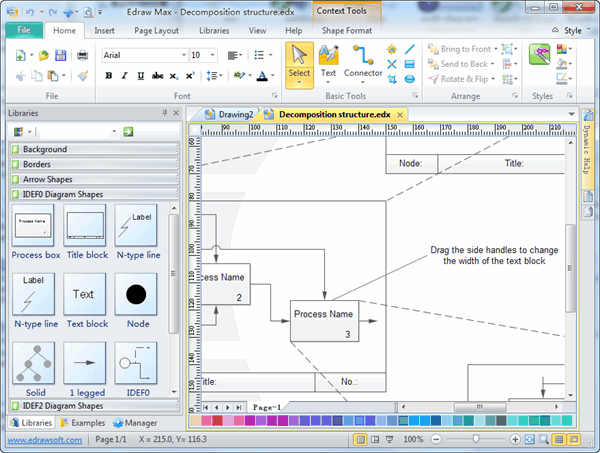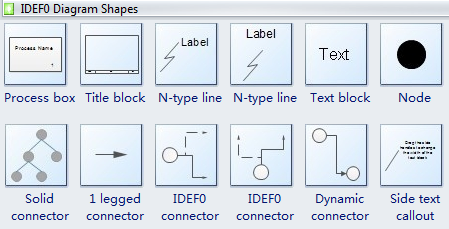IDEF0 Diagram Software - Create IDEF0 diagrams rapidly with examples and templates.
IDEF0 Diagrams Software - Create IDEF0 diagrams and business diagrams rapidly with rich examples and templates. Provide some IDEF0 knowledge.
IDEF Definition
IDEF is based on the Structured Analysis and Design Technique (SADT), a graphical approach to system description, introduced by Douglas T. Ross in the early 1970s. Since then, system analysts at Softech, Inc. have refined and used SADT in a wide variety of problems. In 1981, the U.S. Air Force Program for Integrated Computer-Aided Manufacturing (ICAM) standardized and made public a subset of SADT, called IDEF.
Was originally used to apply structured methods to better understand how to improve manufacturing productivity. IDEF0 was initially created at Northrop Corporation in 1966, and first available commercially by SofTek in 1972. An IDEF0 activity diagram contains one level of decomposition of a process. Boxes within a diagram show the subprocesses of the parent process named by the diagram. Arrows between the boxes show the flow of products between processes.
Innovative IDEF0 Software
Edraw Max is an easy to use IDEF0 diagrams software, which creates IDEF0 diagrams and business diagrams rapidly with rich examples and templates.

Build hierarchical diagrams using IEDF0 process charting models for model configuration management, need and benefit analyses, requirements definitions, and continuous improvement models.
System Requirements
Works on Windows 7, 8, 10, XP, Vista and Citrix
Works on 32 and 64 bit Windows
Works on Mac OS X 10.2 or later
Software Features
Edraw is:- state of the art
- vector-based
- more than just IDEF0, IDEF1, IDEF2 Diagrams which can make over 200 kinds of diagrams
- easy to use with drag and drop interface, premade symbols and automatic formatting tools
- accompanied by a plethora of well-designed templates and examples
- designed with broad file format compatibility
IDEF0 diagrams typically include the following components:
Context diagram - The topmost diagram in an IDEF0 model.
Parent/child diagram - An IDEF0 decomposition hierarchy using parent/child relationships.
Node trees - Tree-like structures of nodes rooted at a chosen node, and used to represent a full IDEF0 decomposition in a single diagram.

The Benefits of Using IDEF0 to Model Business Processes
- Understanding - modeling helps discover the nature of the business being modeled; that is, what is being done in the business.
- Communication - once understanding has been reached, the nature of the business processes can be documented and these documents easily communicated.
- Enlightenment - modeling helps to uncover anomalies, redundancies deficiencies and inefficiencies in the existing (as-is) business process.
- Improvement - a model allows you to select deficient areas of the business and its processes and improve them.
- Redesign - a model provides a tangible basis for redesigning the process, performing simulations of the redesigned (to-be) business process as defined by the strategy. This means that strategies can be tested before implementation takes place.
The IDEF0 Modeling Techniques
An IDEF0 model represents the activities of the business from the point of view of the business, how those business activities interrelate, resources used to conduct each activity, and the result or output of each activity. The model consists of graphics and associated text supporting the graphics.
The IDEF0 modeling technique consists of a graphic language and a modeling process that can be used to develop a rich process description. It is an intuitive way to define, analyze and document the business as a whole and the processes of the business.
 Дисконтированный срок окупаемости
Дисконтированный срок окупаемости Методические аспекты управления проектами
Методические аспекты управления проектами Методология разработки Scrum
Методология разработки Scrum